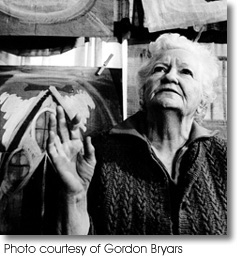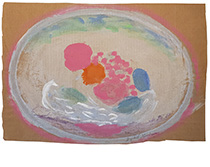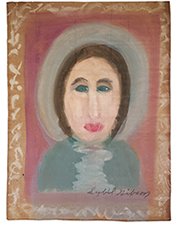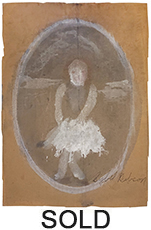(1908 - 1995)
 Sybil Gibson was born Sybil Aaron in Dora Alabama. Although Gibson's father was a properous Alabama coal mine operator, she spent most of her life in proverty. On Thanksgiving Day, 1963, at 55 years of age Sybil began experimenting with making wrapping paper from brown grocery bags and tempura paint, having been seized by an urge to paint. Granger Carr, who befriended Gibson, described her work as follows:
Sybil Gibson was born Sybil Aaron in Dora Alabama. Although Gibson's father was a properous Alabama coal mine operator, she spent most of her life in proverty. On Thanksgiving Day, 1963, at 55 years of age Sybil began experimenting with making wrapping paper from brown grocery bags and tempura paint, having been seized by an urge to paint. Granger Carr, who befriended Gibson, described her work as follows:
"The simple subject matter of flora and fauna are submerged in mystery. Line gives way to light where lyrical hues bleed as in the dome of a rural Alabama sky. Yet form emerges shy of abstraction, retaining the familiarity of distant memory. Evasive flowers become something immediate and urgent. The spirit-like portraits which populate Gibson's work peer as if from behind a veil, and return our gaze as if we, and not they, are the subject matter of something."Shunning regular art paper, Sybil used ordinary grocery bags, which she soaked in water to flatten and separate, or the skins of cardboard boxes, soaked in water to remove the core, and sometimes sheets of newspaper. An eccentric artist who would disappear for long periods of time, she continued to be reclusive throughout her painting career. Often she would leave her paintings behind. Shortly before the opening of her first art exhibition at the Miami Museum of Modern Art in May, 1971, Gibson disappeared, leaving drawings scattered about her yard. Much of her work was destroyed by the elements but there are believed to be about 300 works in existence.
Sybil Gibson's work can be found in many private and public collections including the American Folk Art Museum, the Menello Museum of American Folk Art, the Birmingham Museum of Art, the Montgomery Museum of Fine Arts, the Marietta/Cobb Museum of Arts, the New Orleans Museum of Art, the New York Historical Society and the Fayette Art Museum.
Ref: Hood, "More Than a Pretty Face: The Art of Sybil Gibson", Folk Art Magazine, XXIII, No. 4, (Winter 1998/99); Kemp and Boyer, Revelations - Alabama's Visionary Folk Artists", 1994; Roche, "Unsigned, Unsung, Whereabouts Unknown", Florida State University, 1993; Rosenak, "Contemporary American Folk Art", 1990 and 1996; Sellen, "Folk, Self Taught and Outsider Art", 1993 and 2000.


